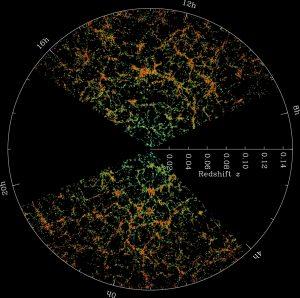The Large Scale Structure (LSS) of the universe refers to the patterns of galaxies and matter on scales much larger than individual galaxies or groupings of galaxies. These correlated structures can be seen up to billions of light years in length and are created and shaped by gravity. Just as gravity on smaller scales pulls together gas particles to make stars, and pulls together stars to make galaxies, it also pulls together galaxies and matter into patterns on larger scales. These patterns often contain large filaments of galaxies, and voids in between, somewhat resembling a spider web, which is why it is often referred to as ‘the cosmic web.’
Studying LSS tells astronomers about the strength of gravity in the universe. Astronomers can measure galaxies at different distances away from the Earth, which correspond to different times in the universe’s history, due to the time their light takes to reach us. We can tell that over time, gravity is attracting more and more matter together, clustering the universe further and further.
Large Scale Structure also tells us about dark energy. Most theoretical models of dark energy act to slow down this process of gravity creating large structures. Essentially, as the universe accelerates in its expansion, it takes more time for matter to come together because it must travel more distance. Studying the growth of large scale structure across time gives us information about gravity, dark energy, and how each may be changing as the Universe evolves with time.

This figure shows galaxies discovered by the Sloan Digital Sky Survey (SDSS). Red points are galaxies with more red star light, indicating older and often larger galaxies. The web-like distribution of galaxies on large scales can be seen by eye. A larger redshift corresponds to a larger distance from Earth, which is at center of the figure. The figure shows galaxies out to around 2 billion lightyears away. The Dark Energy Survey will map galaxy positions out to roughly redshift 1.3 or so, around six times as distant as the furthest galaxies seen here. Figure Credit: M. Blanton and SDSS

This figure shows a simulation of gravity in an expanding Universe. As time goes on (left to right), gravity pulls together matter into large scale patterns. Notice that the pattern on the right (present day) has much more clustered structure than the left-most box (early in the Universe). Also, the Universe expands with time, so every ‘box’ in the Universe is also growing in size. (The expansion has been much bigger since the beginning of the Universe than can be shown here.) These simulations help cosmologists know how gravity is predicted to cluster the Universe over time, which we can compare with our observations. Figure Credit: Andrey Kravtsov, Anatoly Klypin, National Center for Supercomputer Applications (NCSA).